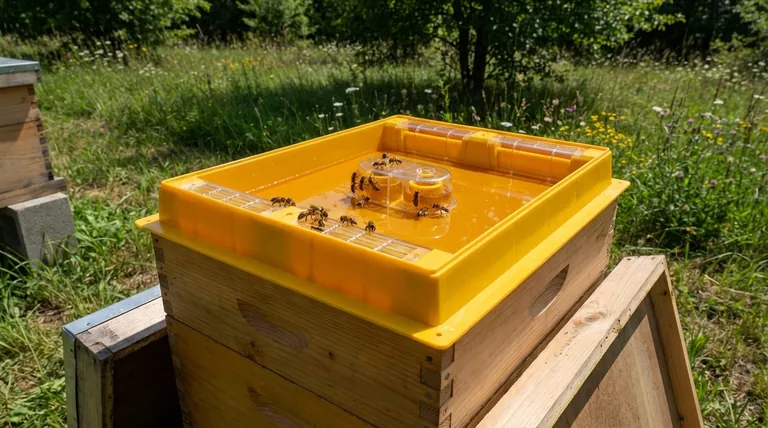To state it directly, the primary advantages of top feeders are their large syrup capacity, the ability to refill them with minimal disturbance to the bees, and their design features that enhance colony safety. These attributes make them an exceptionally efficient tool for beekeepers, particularly when significant feeding is required.
The core value of a top feeder isn't just convenience; it's a strategic tool for maximizing feeding efficiency while minimizing stress on the colony. This makes it an ideal choice for critical periods like fall preparation or for managing apiaries located at a distance.

Maximizing Efficiency with Minimal Intrusion
A beekeeper's goal is to support the colony without causing unnecessary disruption. The design of a top feeder is engineered specifically to meet this objective through its capacity and placement.
Large Volume Capacity
A key advantage is the sheer volume of syrup a top feeder can hold. A standard top feeder for a 10-frame hive can hold up to three gallons or more.
This large capacity reduces the frequency of refills, a significant time-saver for any beekeeper and a critical feature for those managing distant apiaries.
Undisturbed Refilling
Top feeders sit above the inner cover, completely outside the bees' living space. To refill it, you simply remove the telescoping outer cover.
This process does not require you to open the main hive body or disturb the brood nest, which avoids chilling the brood and causing stress to the colony.
Broad Access for the Colony
The design allows a large number of bees to access the syrup simultaneously.
This enables the colony to rapidly consume and store a large quantity of feed, which is especially beneficial during late fall when the window for feeding is short.
Prioritizing Colony Health and Security
Beyond efficiency, a well-designed top feeder incorporates features that directly protect the health and security of the hive.
Drowning Prevention
Modern top feeders are built with safety mechanisms to prevent bees from drowning in the syrup.
These often include steel screens, floats, or integrated "ladders" that allow bees to access the feed without falling in.
Reduced Risk of Robbing
Because the feeder is enclosed within the hive body and covered, it emits very little odor. This makes it significantly less likely to attract bees from other colonies.
This containment drastically reduces the risk of hive robbing, a common and dangerous problem associated with external feeders like entrance feeders.
A Clean and Contained System
The enclosed design prevents leaks and spills inside the hive. This keeps the syrup from dripping onto bees or contaminating frames.
This clean approach ensures the feed remains where it should be and doesn't create a sticky mess that can promote mold or attract pests.
Understanding the Trade-offs
While highly effective, top feeders are not the only solution, and it's important to understand their context compared to other common types.
Comparison to Frame Feeders
Frame feeders, or division board feeders, sit inside the hive body in place of a frame.
Like top feeders, they are well-protected from robbing. However, their primary drawback is that you must completely open the hive to check levels and refill them, causing significant disturbance.
Comparison to Entrance Feeders
Entrance feeders are inexpensive and allow for easy monitoring of syrup levels from outside the hive.
However, their small capacity requires constant refilling, and their placement at the entrance makes them a major catalyst for robbing, as the scent of syrup attracts bees from competing hives.
Making the Right Choice for Your Goal
Selecting a feeder depends entirely on your specific beekeeping objectives.
- If your primary focus is rapid feeding for fall or managing remote hives: The large capacity and minimal disturbance of a top feeder make it the superior choice.
- If your primary focus is providing a small amount of stimulus to a new colony: A frame feeder keeps the feed close to the cluster, though it requires more intrusive refilling.
- If your primary focus is a low-cost, temporary solution: An entrance feeder can work, but you must be extremely vigilant about the risk of robbing.
Ultimately, choosing the right feeder is about aligning your equipment with the specific needs of your colony and your management style.
Summary Table:
| Advantage | Key Benefit |
|---|---|
| Large Capacity | Holds up to 3+ gallons, reducing refill frequency. |
| Minimal Disturbance | Refill without opening the brood nest. |
| Enhanced Safety | Built-in drowning prevention and reduced robbing risk. |
| Rapid Feeding | Allows many bees to access syrup simultaneously. |
Ready to enhance your feeding strategy and protect your investment?
As a commercial beekeeper or equipment distributor, efficient and reliable tools are paramount to your success. HONESTBEE supplies the durable, high-capacity top feeders and other beekeeping equipment designed specifically for the demands of large-scale operations. Our wholesale-focused model ensures you get the quality equipment you need to support healthy, productive colonies.
Contact HONESTBEE today to discuss your apiary's needs and discover how our solutions can save you time and improve your colony's health.
Visual Guide

Related Products
- Professional Hive Top Bee Feeder for Beekeeping
- HONESTBEE Round Hive Top Bee Feeder for Syrup
- HONESTBEE Professional Hive Top Bee Feeder Feeding Solution
- Rapid Bee Feeder White Plastic 2L Round Top Feeder for 8 or 10-Frame Bee Hives
- Professional Hive Front Entrance Bee Feeder
People Also Ask
- What is a top feeder for bees? Maximize Colony Health with Efficient Feeding
- Do I need an inner cover with a hive top feeder? Optimize Your Hive Setup for Healthy Bees
- What are the features of top feeders for bees? Maximize Hive Health with Safe, High-Capacity Feeding
- What is the best bee feeder for a hive? Choose the Right Feeder for Your Apiary's Scale
- What are the advantages of using top feeders for bees? Maximize Feeding Efficiency & Colony Safety



















